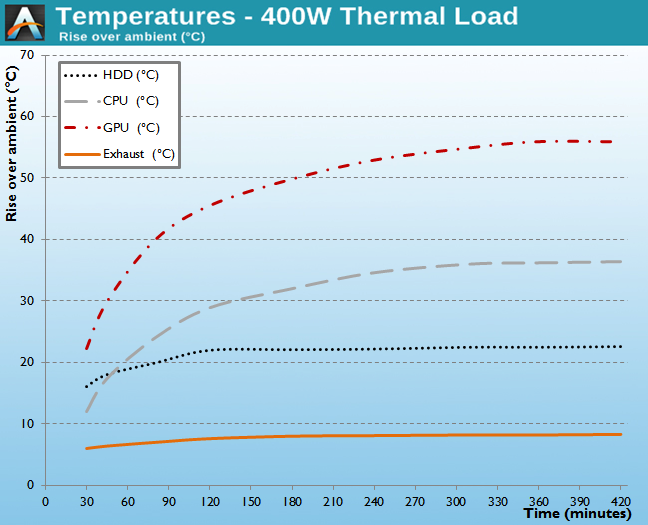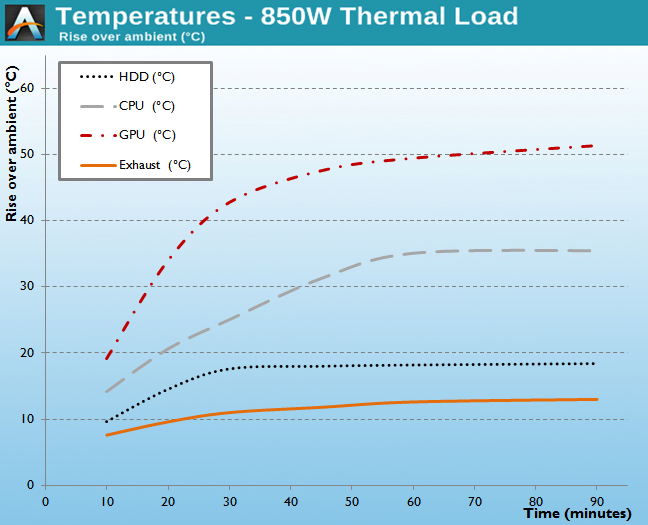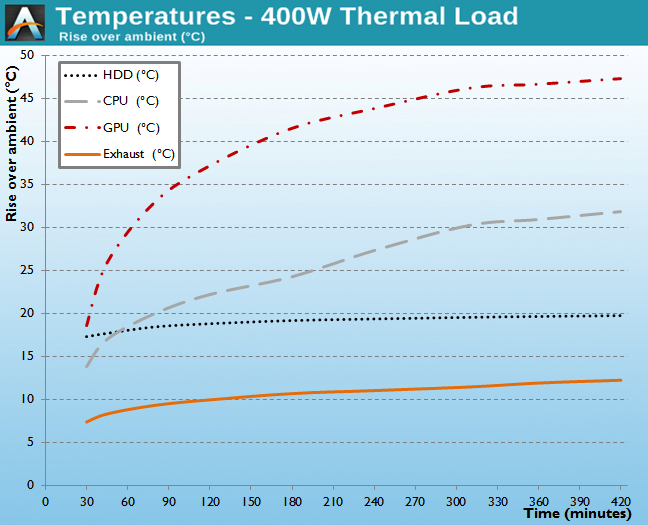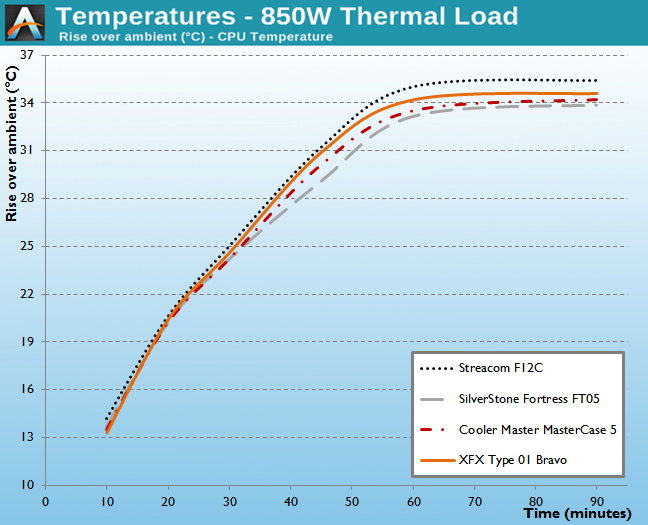The Streacom F12C Aluminum Desktop Case Review
by E. Fylladitakis on September 14, 2015 9:00 AM ESTTest Setup
Professional testing requires the emulation of real-world situations but with repeatable results; thus, a perfectly controllable test setup and environment are required, especially for comparable results. Testing the thermal performance of any case with a typical real-world setup technically limits the comparability of the results to this setup alone, as an active system interacts with its environment and the change of a single component would alter myriads of variables. As such, we developed synthetic loads that emulate the thermal output of real systems, which however are passive, steady and quantifiable. As such, the thermal testing now displays the thermal capabilities of the case alone, as if it would have to deal with the entire thermal load by itself, regardless of the system that would be installed inside it. Laboratory data loggers are being used to monitor the PT100 sensors and control the safety relays, which are fully accessible via our custom software. Three such loads have been developed; the ATX version simulates a 200W CPU, 50W VRM, 30W RAM and 4 × 120W GPU card thermal load. Finally, three 3.5" HDD dummy loads have also been created, with each of them converting 30 W of electrical power to thermal, bringing the total thermal load of the ATX test setup up to 850 Watts. As such, the thermal load is immense and only the best of cases will be able to handle it for more than a few minutes, we are also performing a test with a thermal load of 400W, with all of the aforementioned components except the HDD drives at about 42% power, which is more suitable for the majority of cases.
Noise testing has been performed with a background noise level of 30.4dB(A). Advanced noise testing is also being performed, in order to assess the ability of the case to dampen the noise of the components installed inside it. This includes the installation of two noise-generating sources (strong fans) inside the case, one positioned approximately over the first expansion slot and one over the CPU area, which generate ≈ 44.2 dB(A) when unobstructed. During the advanced noise test, all stock cooling options of the case are entirely disabled.
Note: Due to the nature of the Streacom case's design, the three 3.5" dummy thermal loads were installed to the right of the case, near the front panel, vertically.
Results & Discussion
Thermal testing is usually performed with the stock fans of the case operating at maximum speed. However, the Streacom F12C does not have a single fan installed from the factory. This creates a small impasse, as our thermal load is passive and completely depends on the thermal dissipation capabilities of the case itself. Without any fans, the Streacom F12C depends on just natural air convection. However, a thermal load of 850 Watts cannot be effectively dissipated without any active cooling from the case.
400 Watt Test - No fans installed
As we always test cases with just their stock cooling solutions, we tested the Streacom F12C without any fans installed. The case, as displayed in the graph above, could only handle the reduced thermal load of 400 Watts. If compared to a typical case with active airflow, the F12C would appear far worse. It actually is inferior to a basic Midi-ATX tower case, such as the BitFenix Neos. Still, considering that there was no active airflow, that the F12C could handle a thermal load of 400 Watts is an impressive result.
However, since the F12C is a very advanced (and expensive) case designed to hold very powerful ATX system, we felt that we should also test it considering the presence of fair airflow. As such, we installed three Corsair AF120 fans for a second series of tests. We installed two fans to the left side of the case, as an intake, and one at the middle of the top mounting braces, as an exhaust.
The inclusion of the three cooling fans worked miracles for the thermal performance of the Streacom F12C, which can now compete and even surpass good tower cases. The positive pressure created by the two intake fans pushes the warm air out from the many openings of the case, while the top exhaust fan extracts hot air from the core of the thermal load. With the added airflow, the F12C competes with large tower cases, such as the XFX Type 01, and faces even the SilverStone Fortress FT05, a case with massive stock fans.
As the Streacom F12C has no stock cooling at all, we obviously could not perform any stock acoustics testing either, since there is no noise source. The noise of a finalized system will solely depend on the parts chosen by the user. We had to skip directly to our advanced noise testing, exploring the noise dampening capabilities of the case. Simply put, the Streacom F12C has no such capability at all. Our instruments measured almost the same sound pressure generated by the dummy noise source with it inside the case, i.e. 43.5 dB(A). That is a mere 0.7 dB(A) reduction, an entirely imperceptible difference for any human ear.















45 Comments
View All Comments
Daniel Egger - Monday, September 14, 2015 - link
I fully agree. I also looked specifically for a case with a 5 1/4" bay and front ports. Found the lovely Lian Li PC-C50B which is not only cheaper and offers the mentioned features but also comes with two fans installed, has plenty of space for drives and is available in black which is kind of important since my receiver and other equipment is also black and a silver case would really look like an alien in my living room... One big drawback of the Lian Li case: You *really* have to love screwing because that's what you'll be doing a lot for any tiny hardware change...Bobs_Your_Uncle - Monday, September 14, 2015 - link
This case isn't for me (at least at the current MSRP) but I really, REALLY like quite a LOT of what I see on display in this case:- tolerances on joints, & especially the external panel seams, etc;
- meticulously precise conical chamfering on external AND internal screw inlets, external AND internal;
- the exceptional proportionate balance of radials (fore & aft) expressed in the 1/2 bullnose treatment that weds to the top panel;
- similar radial expression on right & left side panels flowing into the base.
Extensive photos & well angled views reveal that every element of this case is EXACTLY where they intended & every aspect flows into the next PRECISELY as envisioned. Streacom demonstrates a masterful blending of excellent engineering to gifted design.
I seriously like where they're going in this case. Design choices & asthetics can (& should) be questioned & debated. But like them or not, their execution appears beyond reproach. The disclaimer of course is: photographs. But these photos give rise to the craving for an up close & personal stroll around the block.
As it stands, I'll look into the Lian Li PC-C50B. Cuz I do *REALLY* love screwing but so rarely get the pleasure!
angrypatm - Monday, September 14, 2015 - link
It looks as though it's targeted at Apple people, plain, no ports (no versatility). Its pretty, but not friendly.dwatterworth - Monday, September 14, 2015 - link
Fractal Node 605 makes this thing look just plain silly and overpriced.The major problem with attempting to put any GPU's in these horizontal cases, other than blower-style cooler equipped cards, is the airflow. You can either exhaust or supply, a longer GPU blocks nearly the entire airflow path.
The size I think was more to match existing theater components rather than to provide functionality for this case. It's like they had 2 designers who never talked to each other, one thinking of interior layout and one hacking holes into the exterior. Those top grilles...why not make it more functional and get actual full sized filtered opening with fan mounts? That movable rail system is kind of an afterthought I'd say, little correlation to the case layout or component positioning on the motherboard.
Like the article says, the exclusion of any front USB ports is such a huge omission, people will just end up having a USB extension coming from the back of the case and mucking up what could be a clean appearance in an theater setup. No sound absorption materials with that high ticket price is crazy too. At least some padding above the main CPU and GPU areas. Then to mount some potential mechanical drives right up against the aluminum with no dampeners or anything? Yes, I'd love to conduct all vibrations through the case please!
nightbringer57 - Monday, September 14, 2015 - link
Well thing thing certainly does not look like a big storage champion, to be honest. I'd view it more like a network bound machine for HTPC purposes. Just drop in a SSD for the system, a bigger ssd if you plan on gaming (or a second cheaper/GB SSD)ImSpartacus - Monday, September 14, 2015 - link
Yeah, it's hard to understand the use case for this one.DanNeely - Monday, September 14, 2015 - link
I initially assumed it was a scaled up version of the rest of their cases (presumably checkbox marketing driven design); but while bigger than the remainder of their lineup it has a very different design than the rest.Almost of their gallery shots are of black cases; so I'm not sure why they send this model for review. The rest of their cases are a lot more reasonable too; slim mATX/mITX models that either support half height cards or use a riser to mount a full size card or two parallel to the mobo, and with heatsinks that use heat pipes to connect the CPU to the chassis to use as a giant heat sink. I suspect the one case with the PCIe riser is intended for a pair of full height tv capture/etc cards because a GPU would broil in the case. Some of the cases have room for a small fan; but in their intended mode most look like they would probably function just fine passively cooled. Maybe the fan's for if you're using an HDD; I didn't look that closely at layouts.
The best I can say about this case that it might've been a failed experiment; but the PHBs insisted on production to try and recover some of the r&d costs. It's a pity they decided to send it out for review; almost all of their other cases look like they'd've gotten a better reception.
stephenbrooks - Monday, September 14, 2015 - link
It seems to be a common mistake that "sleek, minimalist design" is assumed to mean "remove all the ports".If the company is really phobic about visible ports they could put a flush door in front of them but TBH in my experience doors are more hassle than they're worth. The USB type-C hole is quite elegant, perhaps we could look forward to a future where you just have a regular array of those on the front of the case...
Morawka - Monday, September 14, 2015 - link
wtf is that a GTX 295 Graphics card you installed in that pc? kinda old and outdated ya thinkBrokenCrayons - Monday, September 14, 2015 - link
I think the point was to illustrate the case layout, cable management, and what a finished system will look like inside the box. Since consistently repeatable testing of case thermal and noise properties uses a specifically designed set of hardware component simulators rather than actual computer parts, the parts used to show layout in the photo aren't as important. Besides that, the size and general shape of dual slot, blower-equipped GPUs hasn't significantly changed in quite a few years so a GTX 295 is perfectly reasonable.